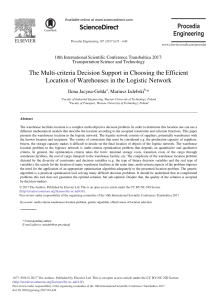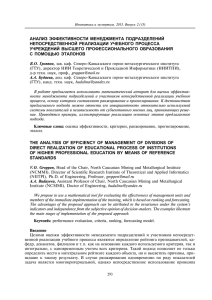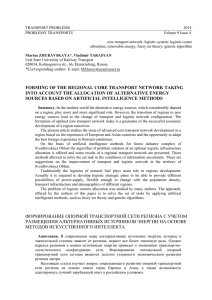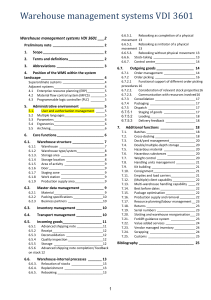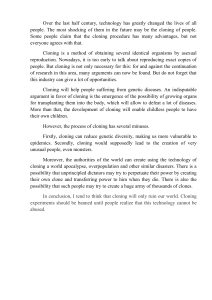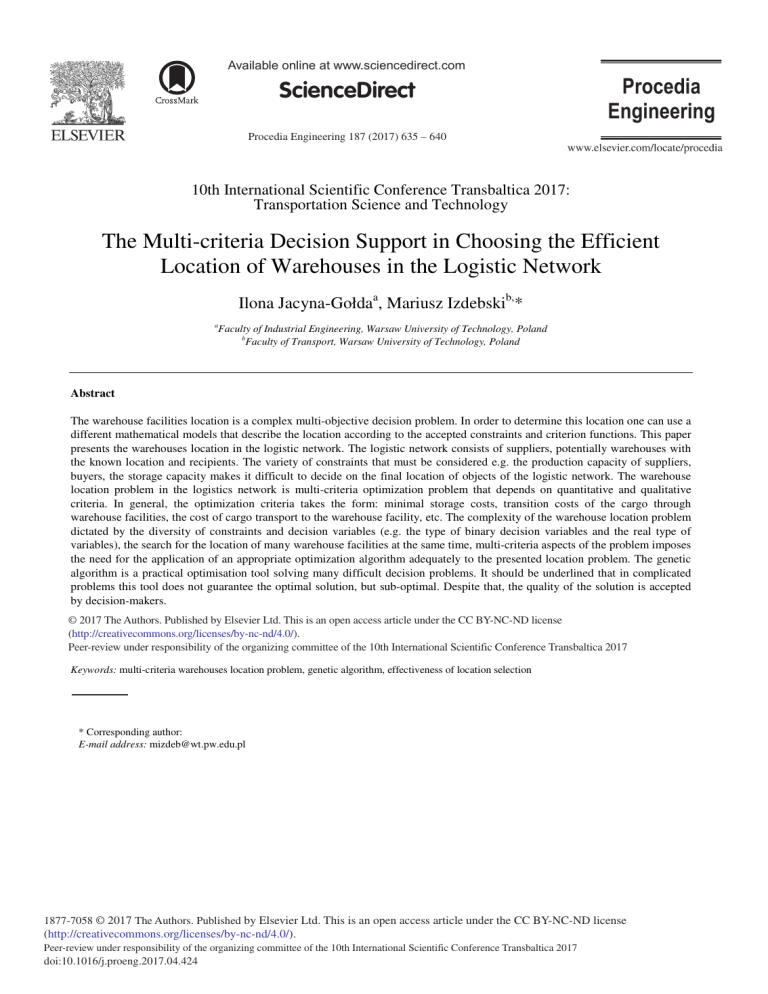
Available online at www.sciencedirect.com ScienceDirect Procedia Engineering 187 (2017) 635 – 640 10th International Scientific Conference Transbaltica 2017: Transportation Science and Technology The Multi-criteria Decision Support in Choosing the Efficient Location of Warehouses in the Logistic Network Ilona Jacyna-Gołdaa, Mariusz Izdebskib,* a Faculty of Industrial Engineering, Warsaw University of Technology, Poland b Faculty of Transport, Warsaw University of Technology, Poland Abstract The warehouse facilities location is a complex multi-objective decision problem. In order to determine this location one can use a different mathematical models that describe the location according to the accepted constraints and criterion functions. This paper presents the warehouses location in the logistic network. The logistic network consists of suppliers, potentially warehouses with the known location and recipients. The variety of constraints that must be considered e.g. the production capacity of suppliers, buyers, the storage capacity makes it difficult to decide on the final location of objects of the logistic network. The warehouse location problem in the logistics network is multi-criteria optimization problem that depends on quantitative and qualitative criteria. In general, the optimization criteria takes the form: minimal storage costs, transition costs of the cargo through warehouse facilities, the cost of cargo transport to the warehouse facility, etc. The complexity of the warehouse location problem dictated by the diversity of constraints and decision variables (e.g. the type of binary decision variables and the real type of variables), the search for the location of many warehouse facilities at the same time, multi-criteria aspects of the problem imposes the need for the application of an appropriate optimization algorithm adequately to the presented location problem. The genetic algorithm is a practical optimisation tool solving many difficult decision problems. It should be underlined that in complicated problems this tool does not guarantee the optimal solution, but sub-optimal. Despite that, the quality of the solution is accepted by decision-makers. © 2017 The Authors. Published by Elsevier Ltd. © 2017 The Authors. Published by Elsevier Ltd. This is an open access article under the CC BY-NC-ND license Peer-review under responsibility of the organizing committee of the 10th International Scientific Conference Transbaltica 2017: (http://creativecommons.org/licenses/by-nc-nd/4.0/). Transportation and Technology. Peer-review underScience responsibility of the organizing committee of the 10th International Scientific Conference Transbaltica 2017 Keywords: multi-criteria warehouses location problem, genetic algorithm, effectiveness of location selection * Corresponding author: E-mail address: [email protected] 1877-7058 © 2017 The Authors. Published by Elsevier Ltd. This is an open access article under the CC BY-NC-ND license (http://creativecommons.org/licenses/by-nc-nd/4.0/). Peer-review under responsibility of the organizing committee of the 10th International Scientific Conference Transbaltica 2017 doi:10.1016/j.proeng.2017.04.424 636 Ilona Jacyna-Gołda and Mariusz Izdebski / Procedia Engineering 187 (2017) 635 – 640 1. The introduction The problem of warehouses location is an issue that is generally known and widely discussed in the context of decision-making problems forming the logistic network [1, 3, 15]. The main objective in the general warehouses location problem is to find such a location of warehouse facilities that the costs arising from forwarding of a specific volume of goods to the customers via warehouses are as low as possible. The warehouses location problem depends on the complexity of the logistics network. The network structure may be single-level [15] (the direct relationship: suppliers – recipients) or multi-level [2, 6, 17, 10] (the indirect relationship: suppliers – intermediate points – recipients) which is called a hierarchical one. The warehouse location problem in the logistics network is multi-criteria optimization problem that depends on quantitative and qualitative criteria. In this issue the following criteria may be distinguished [8, 10]: labour costs, transportation costs, storage costs, taxes, labour characteristics: skilled labour and availability of labour force, existence of modes of transportation, quality and reliability of modes of transportation, proximity to customers, suppliers or producers. The presented criteria emphasise the complexity of the problem arising from location of storage facilities and in a certain way determine the application of the multi-criteria decision-making assistance in selection of the optimum solution [4, 19, 5, 12]. Whereas the warehouses location problem in the logistic network taking into account the one optimization criterion is solved by the use of the genetic algorithm [9, 8] or branch and bound algorithm [1]. In turn multi-criteria decision-making problem of warehouses location is solved by TOPSIS, ELECTRE, Grey Theory methods [20], fuzzy logic [5] or Choquet integral [4]. The main aim of this article is to develop the tool which may be used in the multi-criteria warehouses location problem in the logistic network. In order to solve the multi-criteria warehouses location problem the genetic algorithm was developed. The application of the genetic algorithm in the multi-criteria warehouses location problem was dictated by the fact that the authors do not find the application of this algorithm in the examined multi-criteria problem. Genetic algorithms belong to a group of heuristic algorithms, which do not guarantee the optimal solution, but only close to the optimal solution so-called sub-optimal. Despite this inconvenience genetic algorithms are a practical tool for optimization and are used in a variety complex decision problems e.g. vehicles routing problems [18, 14, 13]. The complexity of the problem of locating warehouse facilities limits the use of accurate methods to find optimal solutions and allows to accept sub-optimal solutions. 2. The warehouses location model The warehouses location model refers to the logistic network which consists of suppliers, warehouses and production companies − recipients. The suppliers provide different types of the raw material to the production companies in a given working day. The material flow between warehouses is possible. The production companies can store the raw material in own warehouses. 2.1. Decision variables The warehouses location is designated on the basis of the decision variables. The first type of the decision variables determines the volume of the raw material which flows between the facilities in a given working day. On the basis of this volume taking into account constraints and criterion functions the warehouses location is determined. The first type of variable is interpreted as the volume of raw materials which are transported between network points in a given working day. The second type of decision variable determines the warehouse location and takes the binary form. The variable assumes the value of 1 when the given warehouse belongs to the logistic network of manufacturing plants and 0 if it does not belong to the logistic network. Ilona Jacyna-Gołda and Mariusz Izdebski / Procedia Engineering 187 (2017) 635 – 640 2.2. Constraints and criterion functions Warehouses location constraints take different forms referring to suppliers, warehouses, recipients. These constraints result from the volume of cargo which flows between these facilities. Main limitations of the model have been defined below: • the production capacity of suppliers cannot be exceeded − suppliers can provide the raw material directly to the recipients or indirectly by the warehouses, • recipients demand must be met − the raw material can flow to the recipients from suppliers or warehouses, • warehouses capacity cannot be exceeded − the raw material can flow to the warehouses from suppliers or other warehouses, • the raw material flowing out from the warehouses cannot exceed the volume of the raw material which is stored in these warehouses, • the maximal processing capacity of warehouses cannot be exceeded, • the minimal stream of the raw material flowing into the warehouses decides about the choice of this warehouses to the logistic network. The selection of locations for warehouse facilities must take into account several multi-criteria aspects. In the warehouses location one can distinguish the following criteria: the criterion of transportation costs between the facilities of the logistic network, the criterion of the transition of the raw material via the warehouses, the criterion of the fuel costs, the criterion of the additional costs associated with warehouses e.g.: local taxes, expenditure on starting the warehouse, the constant costs, the labour force costs, the purchase costs of the additional land for the expansion, the criterion associated with the distance of warehouses from the railway and road infrastructure. In order to solve this location problem described by the above-mentioned the decision variables, constraints and criteria the genetic algorithm was developed. 3. The genetic algorithm for multi-criteria warehouses location problem A genetic algorithm was used to determine the volume of the raw material which flows between particular facilities in the network. On the basis of this volume taking into account the constraints and the criterion functions the warehouses location is determined. To form a genetic algorithm it is advisable to define the chromosome structure, the adaptation function, cross-linking process and mutation [14]. The cross-linking process and mutation are reiterated a given number of times, until the stop condition has been achieved. A condition for stop in the developed algorithm is the fixed iterations number. In the selection process the roulette method was adopted, while the process of cross-linking and mutation occurs with a defined likelihood set at the beginning of functioning of an algorithm. In order to prevent early convergence of the algorithm linear scaling was used [7]. 3.1. The chromosome structure The structure of input data was presented as matrices M(t, h), which present the flow of the raw materials (h) between particular elements of the logistics network in a given working day (t). On the basis of volumes in the matrix M(t, h) the all criterion functions presented in the chapter 2.2 can be calculated. The crucial issue is the determination of the correctly structure processed by the algorithm that meets limitations of the demand of production companies, possibilities offered by suppliers, capacity of warehouses etc. For another types of the raw material the matrices should be generated in the same way. This process needs to be repeated for each working day taking into account the volume of the raw material which was stored in the warehouses in previous days. 637 638 Ilona Jacyna-Gołda and Mariusz Izdebski / Procedia Engineering 187 (2017) 635 – 640 3.2. The adaptation function On the basis of the adaptation function the genetic algorithms designate the final solution. The genetic algorithms look for the maximal solution. In order to take into account the mentioned aspect and different criterion functions the adaptation function must take the following form: F= F1(rnd) F1 + F 2(rnd) F2 + F3(rnd) F3 + F 4(rnd) F4 + F5(rnd) F5 + F 6(rnd) F6 ⎯⎯→ max . (1) All decision variables can be read with the matrix M(t, h). In order to be able to add the values of all criterion functions the adaptation function needs to be presented as the sum of quotients where e.g.: F1(rnd) determines the randomly value of the criterion function and F1 determines the value which was generated by the genetic algorithm. The function F will reach the maximum value in the case where the criterion functions F1 – F6 will reach the minimum according to the assumptions of these functions. In the case where the criterion function e.g.: F1 looks for the maximum value so this function must be put in the numerator. 3.3. The cross-linking operation The cross-linking operator is adequate to the adopted matrix structure. To implement the cross-linking process for each day (t) and for each type (h), two matrices are developed: DIV(t, h) which comprises rounded up average values from both parents, and matrix REM(t, h) containing information whether the rounding up was indeed necessary. The full description of the cross-linking process was presented in [14]. The values with the matrix REM are added to the matrix DIV. As a result of this operation two new structures are developed. The applied crosslinking operator guarantees the correctness of individuals following a completed cross-linking process, without the necessity of using repair algorithms. 3.4. The mutation operation The operation rule of mutation operator consists in sampling of two figures p and q from the range: 2 ≤ p ≤ k and 2 ≤ q ≤ n, which determine the number of lines and columns of a submatrix with dimensions p × q (k − number of lines in the main matrix (processed by the algorithm), n − number of columns in this matrix). The generated matrix is modified in such a way that the total value in columns and lines before and after the modification process is not changed. The detailed mutation process has been outlined in [14]. The final effect of the genetic algorithm is matrix M(t, h) for one type of the raw material and one day of work. For another types of the raw material and days another matrices must be designated. The final matrix M(t, h) for a given working day contains all types of the raw materials which are transported between the facilities. On the basis of this matrix the warehouses location is determined for a given working day. 3.5. The results For the example data (for one type of the raw material and in first day of work) the genetic algorithm was implemented in the C# programming language. The number of iterations was set on 200. The mutation likelihood was set on respectively: p_mut = 0.01; 0.03; 0.05. The number of population: 50 chromosomes (matrices). The graphical presentation of results was presented in the Fig. 1. The cross-linking likelihood was set on respectively: a) 0.6 and b) 0.8. The linear scaling factor for the genetic algorithm accordance with the recommendations of the literature [14] assumes the value 2.0. In order to present in clearly form of the results generated by the algorithm the adaptation function F was multiplied be the value 10000. It should be noted that the given solution is not optimally and depends on many factors i.e. randomly initial populations of chromosomes, the cross-linking and mutation likelihood, the number of iterations, the way of Ilona Jacyna-Gołda and Mariusz Izdebski / Procedia Engineering 187 (2017) 635 – 640 selection. All of this factors are selected in randomly way and the stage of designating the finished solution is preceded by many tests with different setting of parameters. a) b) Fig. 1. The results of the genetic algorithm. 4. Conclusions The multi-criteria decision support in choosing the efficient location of warehouses in the logistic network is based on the work of the genetic algorithm. The optimal results generated by the algorithm depends on the many parameters e.g.: mutation, cross-linking, the number of iterations, the size of the population. The selection of these parameters takes place in the randomly way. In the implementation of the genetic algorithm the different combinations of these parameters were examined e.g.: 200 chromosomes, 100 iterations, cross-linking likelihood 0.2 etc. It should be emphasized that the generated solution by the genetic algorithm is sub – optimal. The further research in the context of the use of the genetic algorithm in the multi-criteria decision support in choosing the efficient location of warehouses will be conducted using other selection methods described in the literature. Acknowledgements The scientific work carried out in the frame of PBS 3 project “System for modeling and 3D visualization of storage facilities” (SIMMAG3D) financed by the NCBR. References [1] U. Akinc, B. M. Khumawala, An efficient branch and bound algorithm for the capacitated warehouse location problem, Management Science 23(6) (1977) 585–594. [2] T. Ambroziak, M. Jacyna, M. Wasiak, The Logistic Services in a Hierarchical Distribution System, Chapter 30, in. Goulias K.: Transport Science and Technology, ELSEVIER, 2006, pp. 383−393. [3] M. L. Brandeau, S. S. Chiu, An overview of representative problems in location research, Management Science 35(6) (1989) 645–674. [4] T. Demirel, N. Demirel, C. Kahraman, Multi-criteria warehouse location selection using Choquet integral, Expert Systems with Applications 37 (2010) 3943–3952. [5] B. Dey, B. Bairagi, B. Sarkar, S. K. Sanyal, Warehouse location selection by fuzzy multi-criteria decision making methodologies based on subjective and objective criteria, International Journal of Management Science and Engineering Management 0 (2015) 1−17. [6] A. M. Geoffrion, G. W. Graves, Multicommodity distribution system design by Benders decomposition. Management Science 2 (1974) 82– 114. [7] D. E. Goldberg, Algorytmy genetyczne i ich zastosowanie, Wydawnictwo Naukowo – Techniczne Warszawa. 1995. [8] M. Izdebski, I. Jacyna-Gołda, M. Wasiak, Adoption of genetic algorithm for warehouse location in logistic network, Journal of KONES Powertrain and Transport 23(3) (2016) 201–209. [9] I. Jacyna-Gołda, M. Izdebski, E. Szczepański, Assessment of the Method Effectiveness for Choosing the Location of Warehouses in the Supply Network, Challenge of Transport Telematics Springer 640 (2016) 84−97. [10] I. Jacyna-Gołda, Chosen aspects of logistics network design method for production service companies, International Journal of Logistics Systems and Management, Inderscience 15 2/3 (2013) 219–238. 639 640 Ilona Jacyna-Gołda and Mariusz Izdebski / Procedia Engineering 187 (2017) 635 – 640 [11] I. Jacyna-Gołda, K. Santarek, M. Wasiak, Location of warehouse facilities in the logistics network, w: J. Feliks (ed.), Conference Proceedings Carpathian Logistics Congress, Tanger, 2013, Kraków 2013. [12] M. Jacyna, Multicriteria Evaluation of Traffic Flow Distribution in a Multimodal Transport Corridor, Taking into Account Logistics Base Service. Archives of Transport 10(1−2) (1999) 43−66. Warsaw. ISSN 0866-9546. [13] K. Lewczuk, The concept of genetic programming in organizing internal transport processes. Archives of transport, Polish Academy of Sciences 34(2) (2015) 61−74. Warszawa. ISSN 0866-9546. [14] Z. Michalewicz, Algorytmy genetyczne + struktury danych = programy ewolucyjne, Wydawnictwo Naukowo – Techniczne, Warszawa. 1996. [15] R. R. K. Sharma, V. Berry, Developing new formulations and relaxations of single stage capacitated warehouse location problem (SSCWLP): Empirical investigation for assessing relative strengths and computational effort, European Journal of Operational Research 177(2) (2007) 803–812. [16] T. Özcan, N. Çelebi, Ş. Esnaf, Comparative analysis of multi-criteria decision making methodologies and implementation of a warehouse location selection problem, Expert Systems with Applications 38(8) 9773–9779. [17] R. R. K. Sharma, Modeling a fertilizer distribution system, European Journal of Operational Research 51 (1991) 24–34. [18] E. Szczepański, I. Jacyna-Gołda, J. Murawski, Genetic algorithms based approach for transhipment HUB location in urban areas. Archives of Transport 31(3) (2014) 73-82. ISSN 0866-9546. [19] M. Wasiak, I. Jacyna-Gołda, M. Izdebski, Multi-criteria warehouses location problem in the logistics network, International Conference on Industrial Logistics (ICIL 2016), Conference Proceedings, Zakopane, Poland. 2016, pp. 352–363. ISBN 978-83-62079-06-3.
